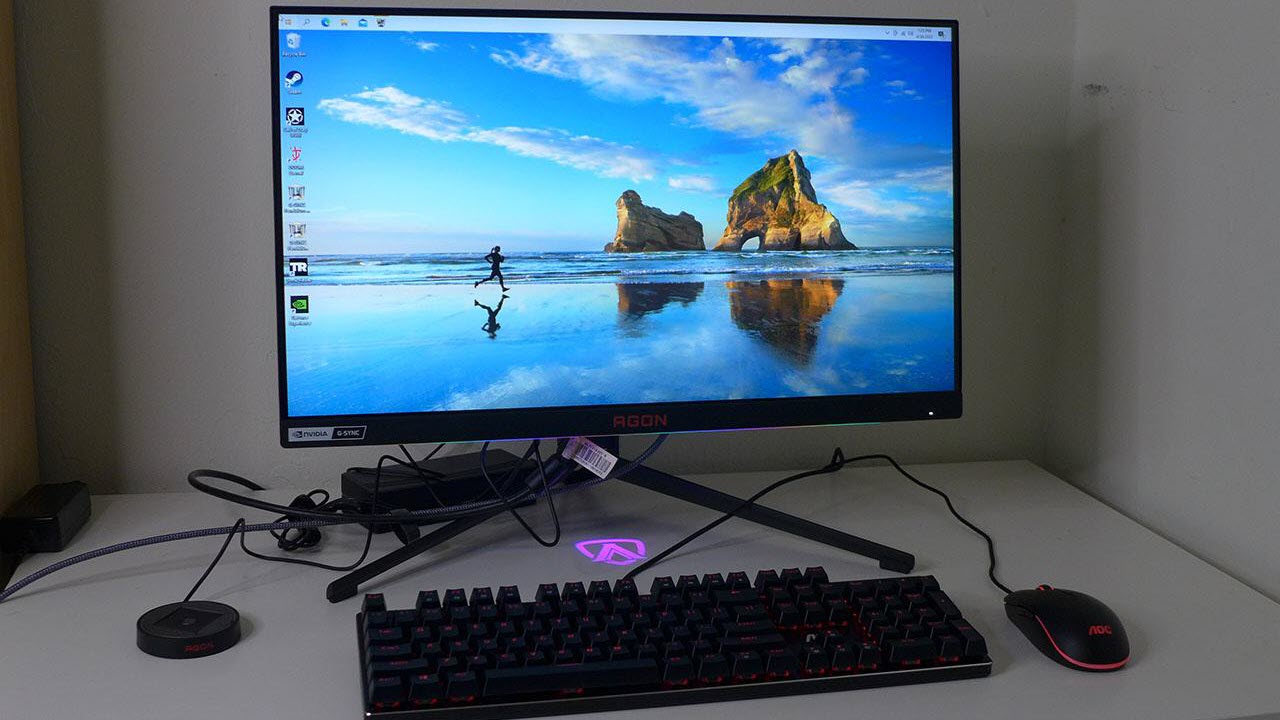Tom's Hardware Verdict
The AOC Agon AG254FG is a sharply focused tool for premium and competitive gaming. It does other things well but if you want the fastest possible monitor for a high-end gaming system, it is only equaled by other 360 Hz displays.
Pros
- +
Bright image with best-in-class SDR and HDR contrast
- +
Accurate out-of-box color
- +
Phenomenal motion resolution at high frame rates
- +
Solid build quality with premium styling
Cons
- -
Color gamut limited to sRGB
Why you can trust Tom's Hardware
There are so many great gaming screens today, with such a wide array of focus and features, that it can be hard to choose the best gaming monitor. My recommendation is always to consider your needs/wants and pick the right tool for the job. With a large array of screen sizes, shapes, resolutions, speeds and features, it’s safe to say that displays have become more specialized in their design intent.
While most people consider resolution foremost, competitive gaming has its own set of requirements. If an esports player wants every possible advantage, they’ll need a stout PC and a high-performance display. 144 Hz is now a starting point. 240 Hz is fast, but 360 Hz is the current pinnacle (although even faster displays are coming soon). When motion resolution is the main focus, nothing available today can beat a 360 Hz monitor, even though they all currently run at FHD (1080p) resolution.
There are a number of these premium panels available, but here we'll be looking at the latest addition to AOC’s Agon Pro line, the AG254FG. It’s a 24.5-inch IPS panel with 360 Hz, Adaptive-Sync and HDR. While it may be difficult for some to wrap their minds around a 24.5-inch FHD panel that costs $750, you won’t care about the price once you’ve seen it in action.
AOC Agon AG254FG Specs
| Panel Type / Backlight | IPS / W-LED, edge array |
| Screen Size / Aspect Ratio | 24.5 inches / 16:9 |
| Max Resolution and Refresh Rate | 1920x1080 @ 360 Hz |
| Row 3 - Cell 0 | G-Sync Certified |
| Row 4 - Cell 0 | FreeSync compatible |
| Native Color Depth and Gamut | 8-bit (6-bit+FRC) / sRGB |
| Response Time (GTG) | 1ms |
| Brightness (mfr) | 400 nits |
| Contrast (mfr) | 1,000:1 |
| Speakers | 2x 5w w/DTS |
| Video Inputs | 1x DisplayPort 1.4 |
| Row 11 - Cell 0 | 2x HDMI 2.0 |
| Audio | 2x 3.5mm headphone output |
| Row 13 - Cell 0 | 1x microphone input |
| USB 3.2 | 1x up, 4x down |
| Power Consumption | 26w, brightness @ 200 nits |
| Panel Dimensions WxHxD w/base | 21.7 x 15.5-20.6 x 12.1 inches (552 x 394-524 x 308mm) |
| Panel Thickness | 2.8 inches (72mm) |
| Bezel Width | Top/sides: 0.2 inch (6mm) |
| Row 19 - Cell 0 | Bottom: 0.9 inch (23mm) |
| Weight | 14 pounds (6.4kg) |
| Warranty | 4 years |
The two things that separate rank-and-file gaming monitors from the high-end models are response and motion resolution. The resolution of a moving image is far lower than a panel’s static resolution. Pixel count takes a back seat to refresh rate. The higher the rate, the greater integrity a moving picture has. 240 Hz is very good and dominates the QHD genre, but 360 Hz is another level entirely.
The AG254FG employs a Fast IPS panel with FHD resolution. The 360 Hz refresh rate is achieved here without overclock. Adaptive-Sync comes with a certification from Nvidia for G-Sync and FreeSync operation from 48-360 Hz, as confirmed by my testing. Also included is the latest G-Sync module, which has DisplayPort 1.4 and two HDMI 2.0 ports.
In the OSD, you’ll find a G-Sync Processor sub-menu which gives you access to the Nvidia Reflex Latency Analyzer. Using a compatible mouse, you can monitor actual control lag in real-time. Here’s a more in-depth look at Nvidia Reflex. The module also enables ULMB, a blur-reducing backlight strobe at speeds up to 240 Hz with variable pulse width. Put simply: less blur means less light as the black frame insertion time increases.
Image-wise, the AG254FG is an sRGB display. That means it will not provide extended color for HDR content. HDR10 is supported, though with an effective dynamic contrast feature that topped 11,000:1 in my tests. That makes it the top-performing HDR screen of all the 360 Hz displays I’ve tested. It also delivers super-accurate color out of the box. I was able to calibrate the AG254FG, but the adjustment is completely unnecessary. There’s plenty of light available with over 400 nits peak in SDR and HDR modes.
Get Tom's Hardware's best news and in-depth reviews, straight to your inbox.
The feature list rounds out with a slick lighting effect that includes a desktop projector, lights on the back and an LED bar on the bottom of the bezel. It’s all controllable from the OSD or AOC’s G-Menu desktop app with a myriad of effects and colors. You also get an aiming point, frame counter and the already-mentioned Reflex Latency Analyzer. The AG254FG is a premium gaming screen, and nothing short of another 360 Hz monitor can do what it does. Let’s take a look.
Assembly and Accessories
The AG2564FG ships in a substantial carton that is a bit taller than expected. That’s to accommodate the rigid shading hood packed in its own box. The panel, upright and base don’t require tools to assemble, but I found the captive bolt in the base to be too recessed for my fingers. The included Phillips-head screwdriver will make this step easier. Another box houses the accessories, external power supply, cables for USB, DisplayPort and HDMI, and a pair of stand clips to keep the wiring tidy.
Product 360
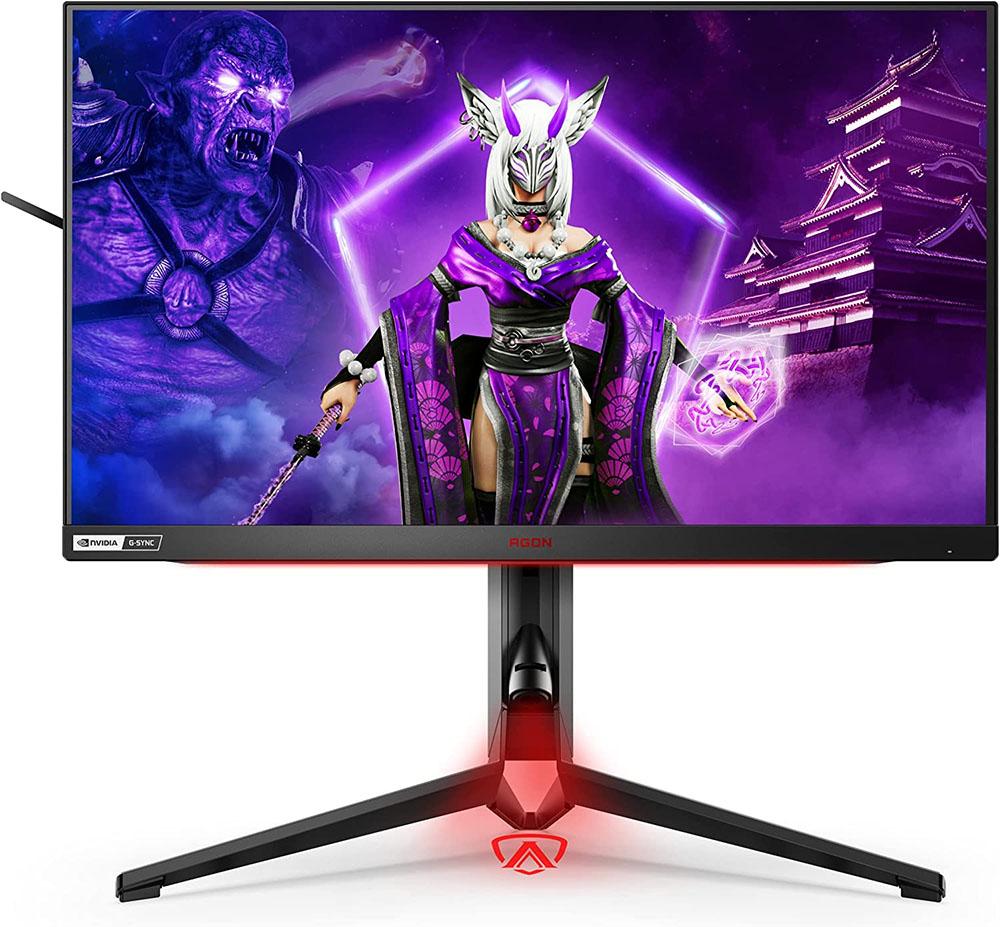
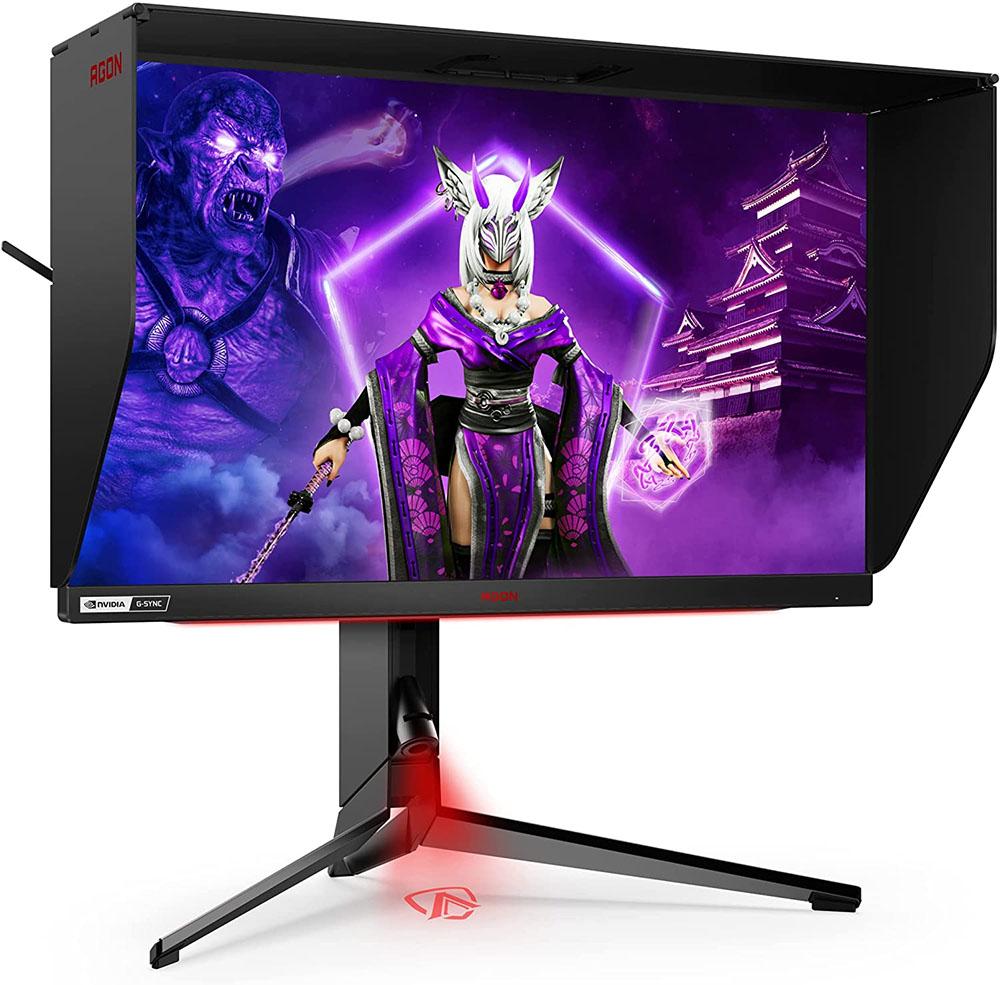
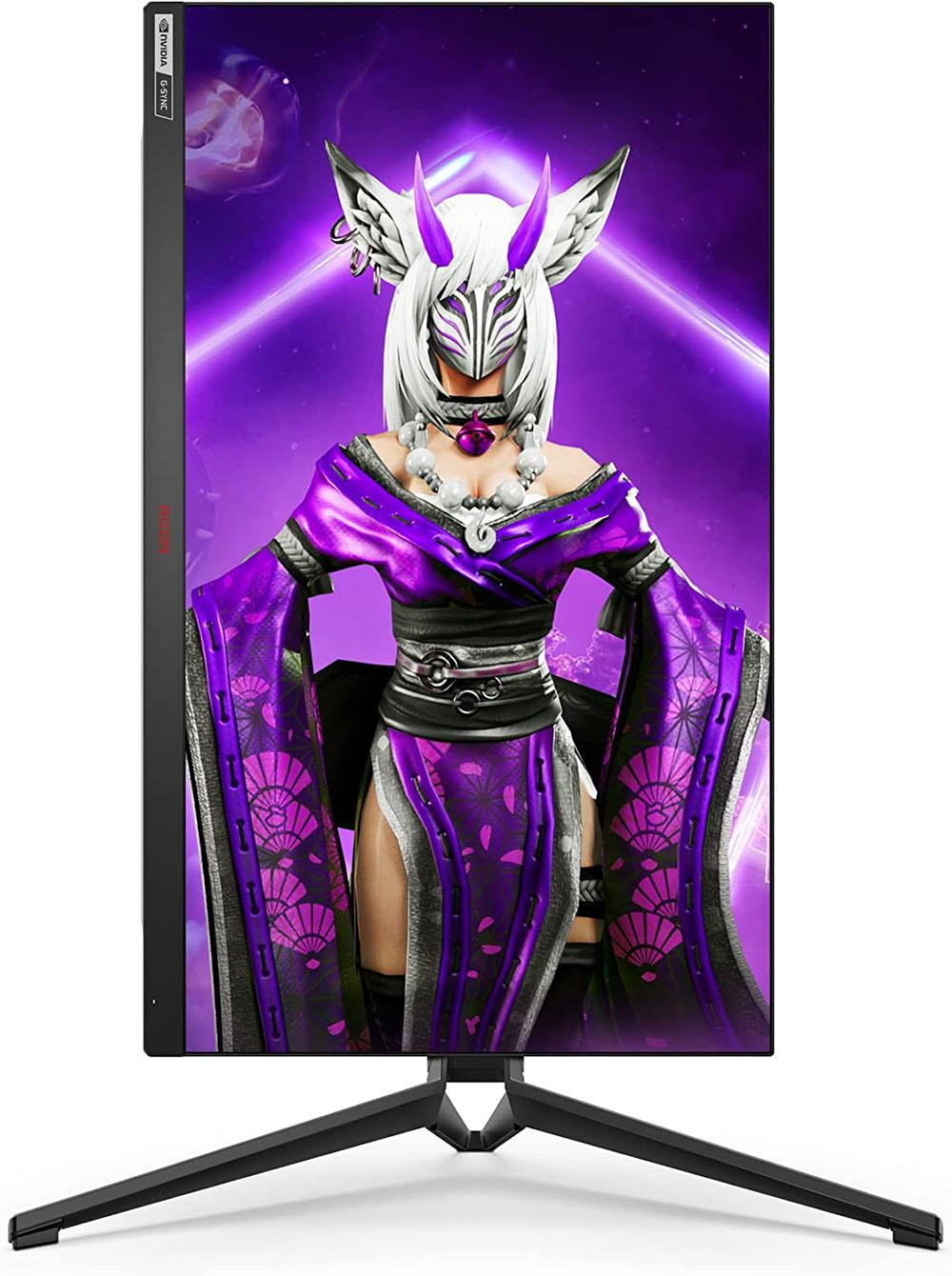
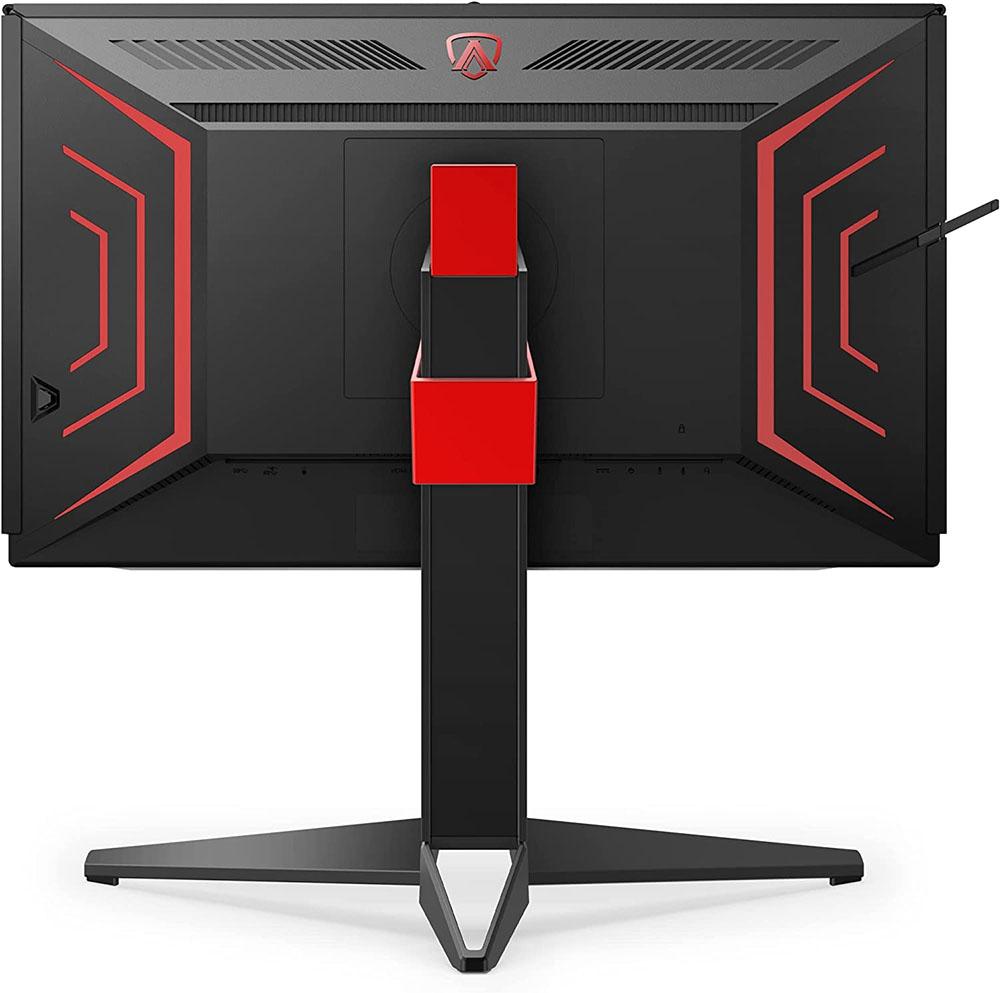
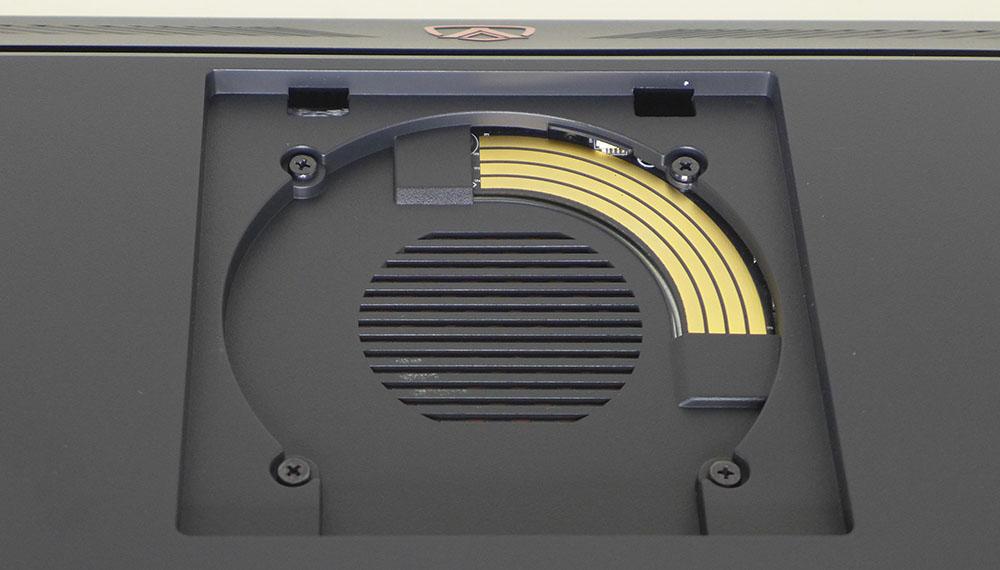

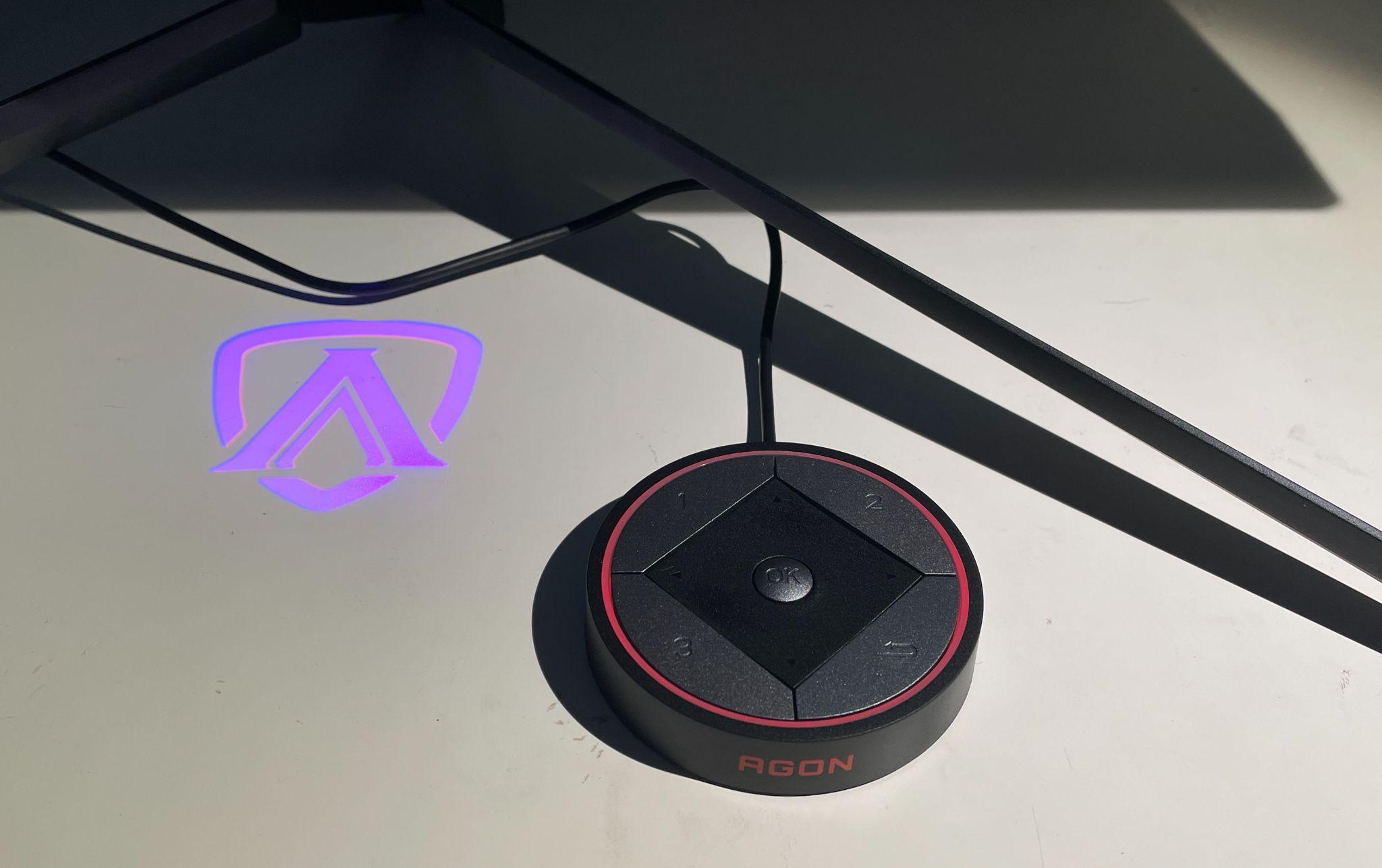
AOC’s Agon gaming monitors have their own set of styling cues that include red trim, sharp angles and specific graphics. In fact, the front bezel only says “Agon;” AOC does not appear anywhere. In case that logo isn’t enough, a small projector on the stand displays the Agon logo or the word Agon on your desktop. A little slider switches between the two images, and you can make it any color you want at three intensity levels. Additional lighting is found in a diffused bar across the bottom edge of the panel and on the back, where you’ll see six bracket shapes. Light effects can be static or moving. You’ll notice on the closeup photo of the back contacts for the base’s projector. They maintain their connections no matter where you rotate the panel.
The stand is rock solid and one of the best I’ve seen from AOC. The base appears thin from the front. But change your angle of view and you’ll see it’s quite stout. It’s solid metal, as is the red collar that wraps around the upright and supports the panel. That part is finished in a matte red that looks very high-end. At the top of the upright is a handle, also made from red-finished metal. On the left side is a tiny slide-out headphone hook. Around the back right is the AG254FG’s tiny joystick. You can also plug in an included controller puck to navigate the OSD. Power status is indicated by a white LED on the front.
Ergonomics include a 90-degree portrait mode, which I rarely see from new monitors. You also get 5.1 inches of height range, 30 degrees swivel to either side and 5/23 degrees tilt. Movement feel and quality are befitting a monitor of this price and status. The AG254FG is a premium piece of hardware in every respect.
The three-piece shading hood is a pro-quality piece, rigid with a light-absorbing felt lining and a door on top to accommodate a light meter. It even has a slot on the left side to allow the headphone hook to come out. The hood snaps in place and can be easily removed if desired. Using it keeps the screen completely free of reflections and enhances perceived contrast.
The input panel offers two HDMI 2.0 ports and one DisplayPort 1.4. USB is version 3.2 and includes one upstream and four downstream connections. The yellow port is for charging and the green is for the special mouse needed for the Reflex Latency Analyzer. Audio is supported by two 3.5mm outputs and one microphone input. The mini-USB port next to the DC jack is for the OSD controller puck called QuickSwitch.
OSD Features
The AG254FG’s OSD uses large icons for its eight sub-menus. It pops up in the lower-right corner, but you can move it anywhere on the screen you like. To make it appear, press the joystick or the puck’s center button.
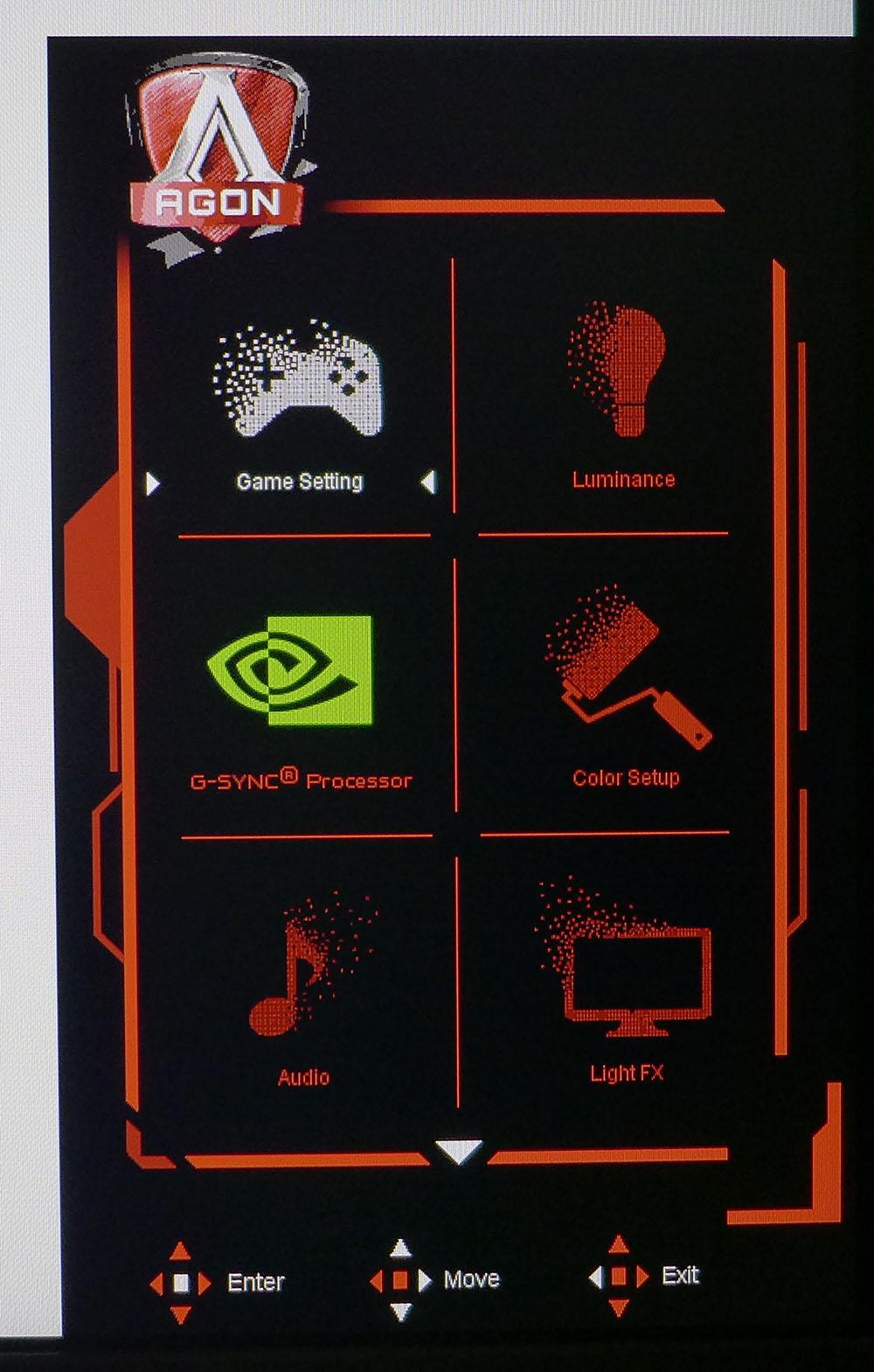
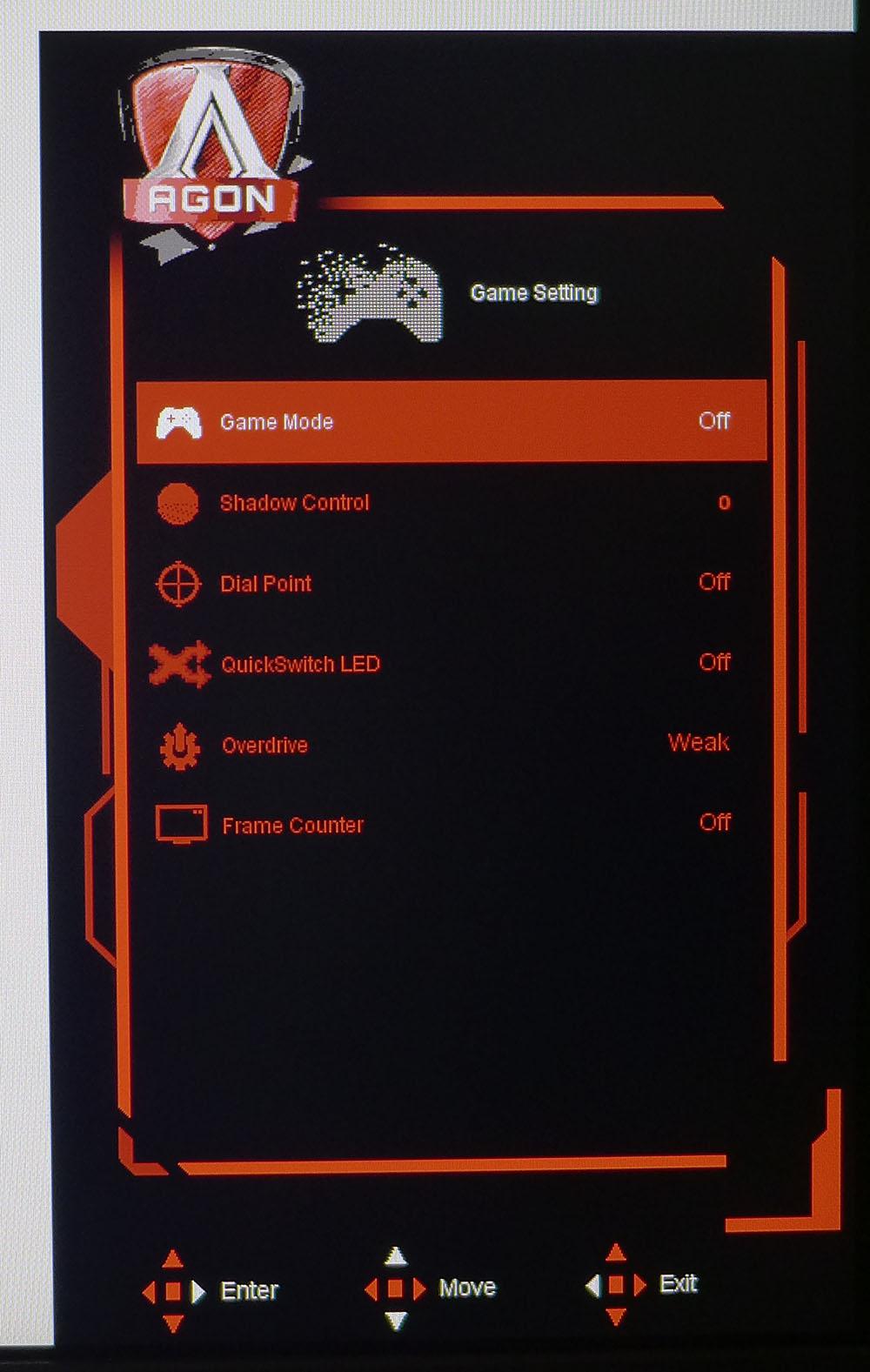
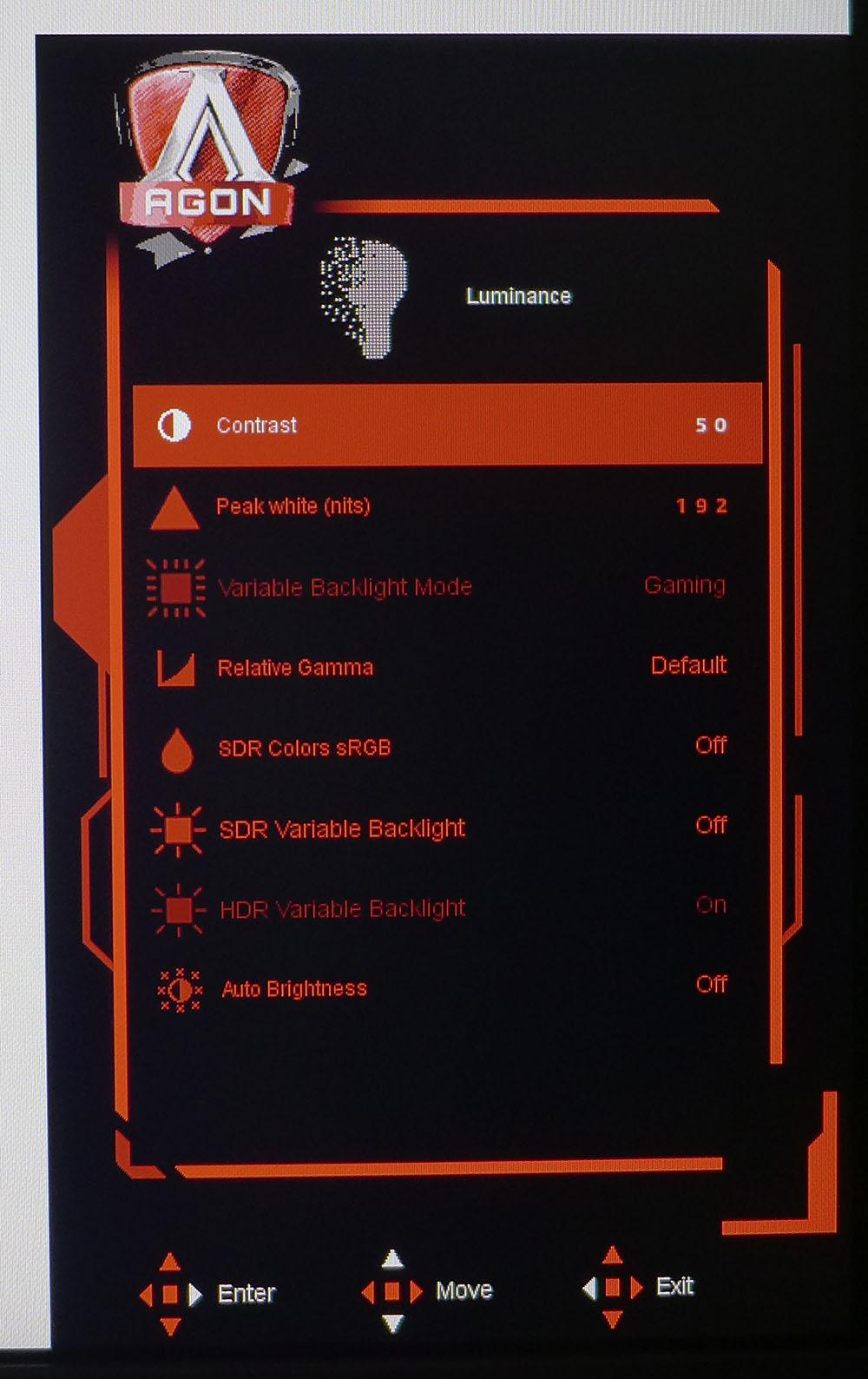
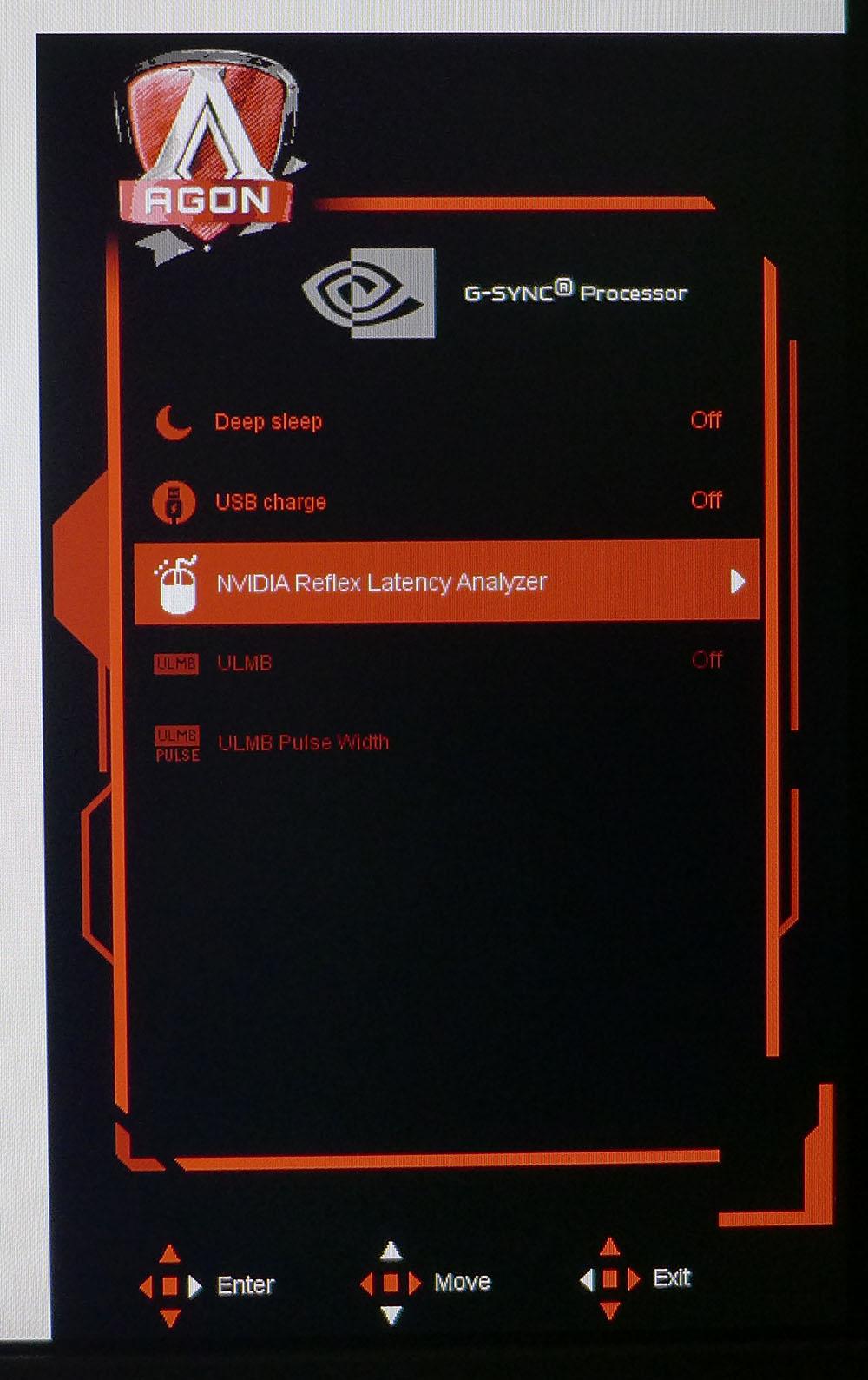
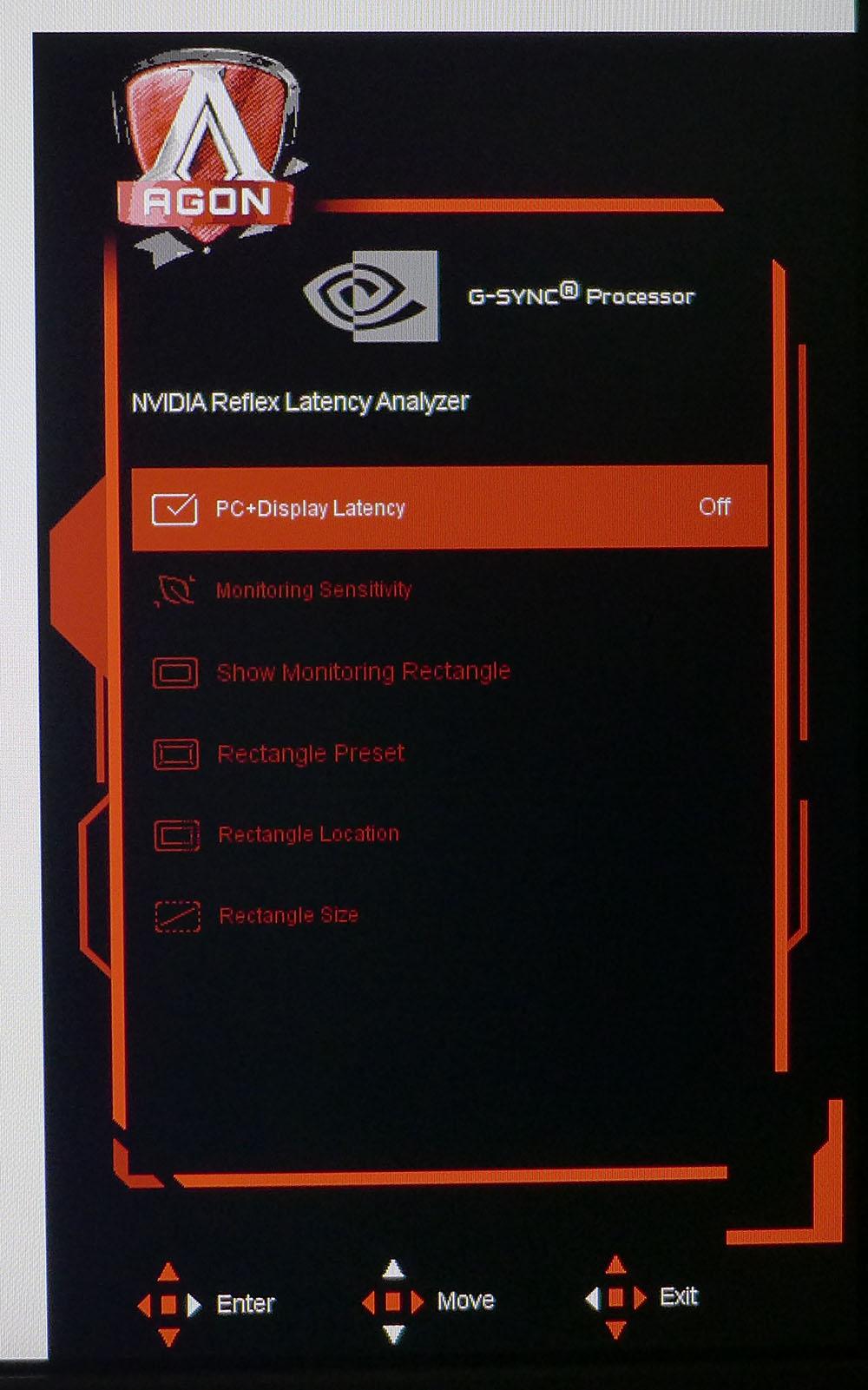
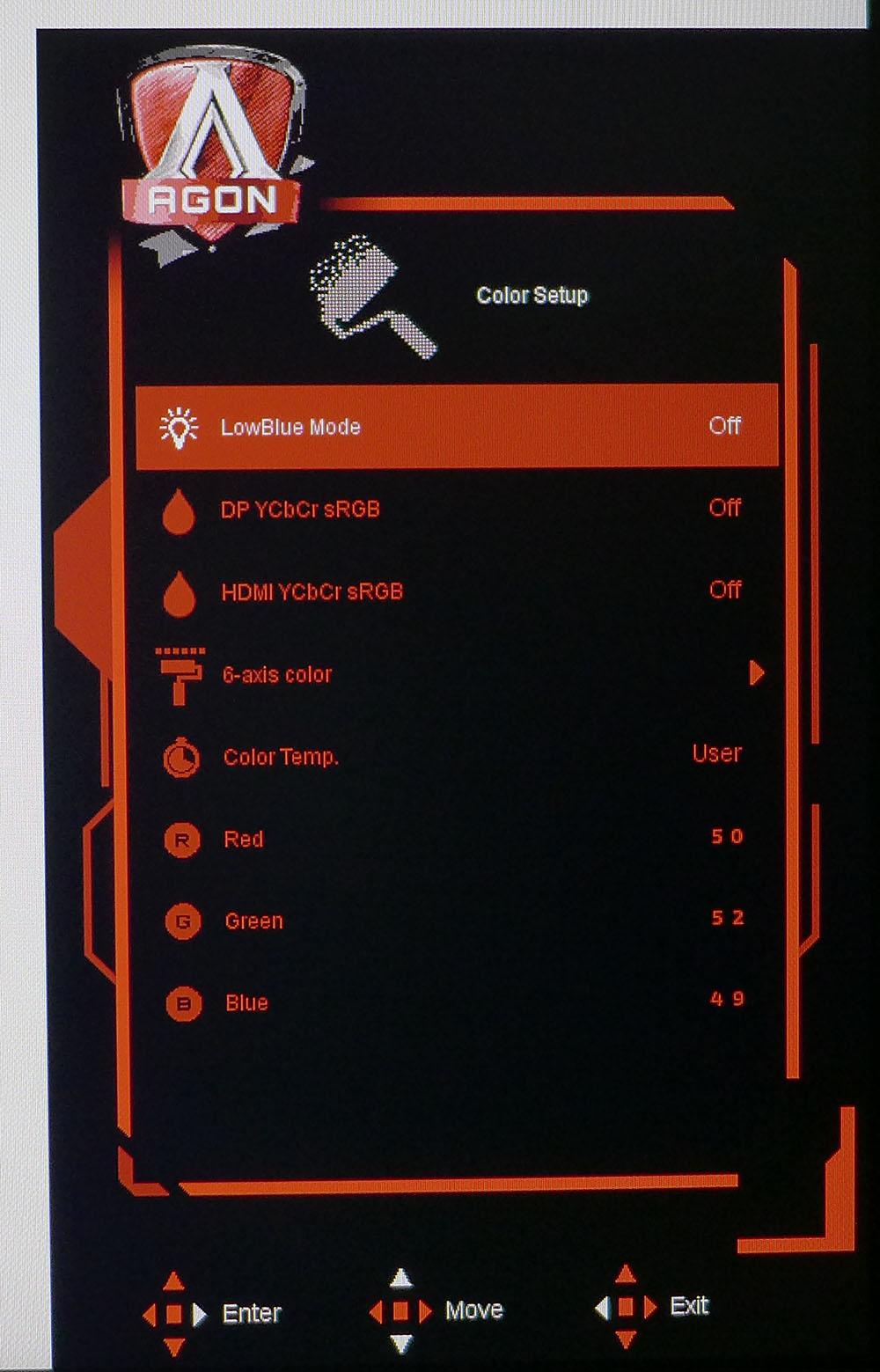
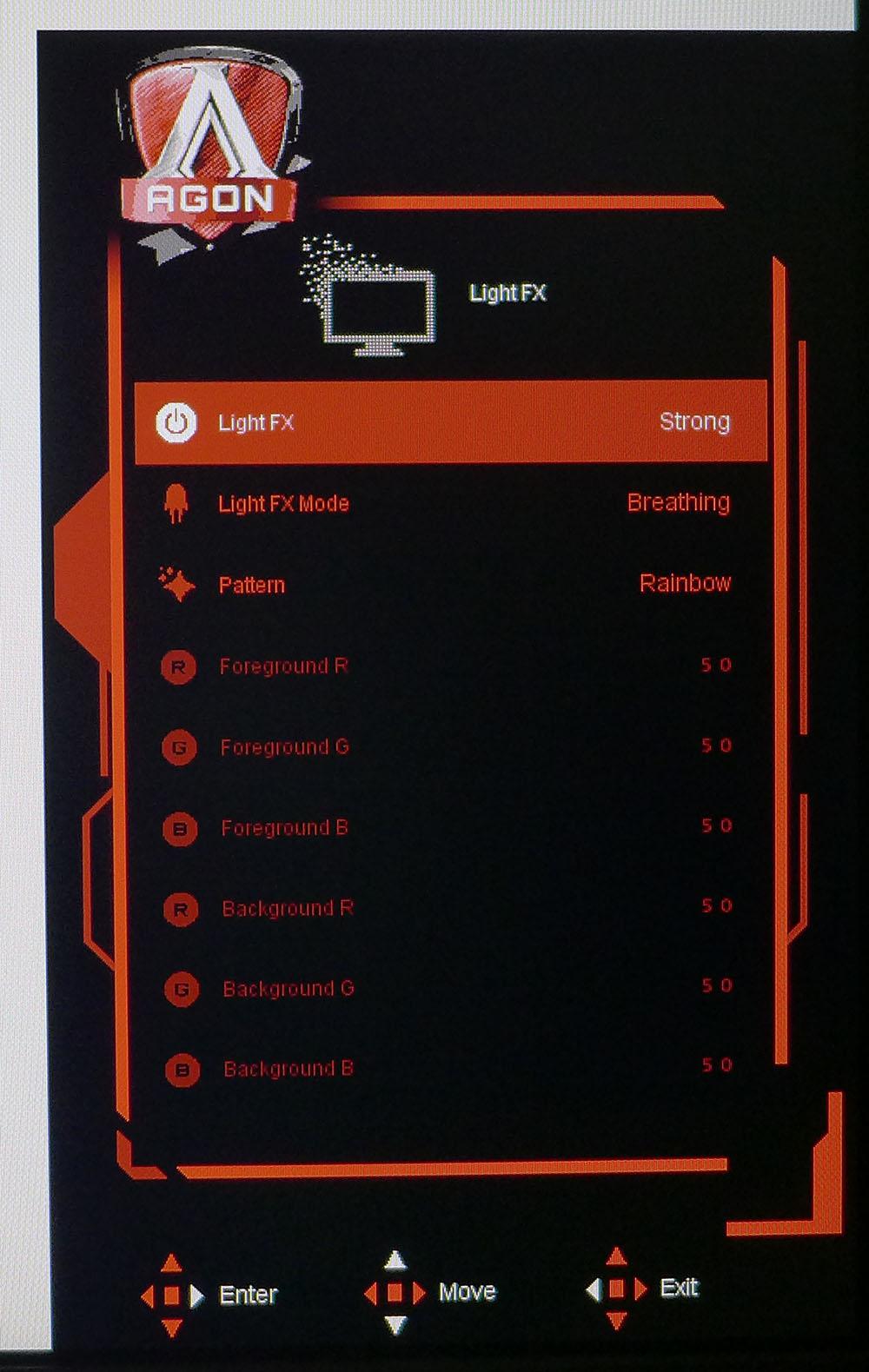

The picture modes are called Game Mode and there are seven choices, plus Off. The latter is the default and best choice because it’s spot-on accurate out of the box and leaves all image controls available. Also in this menu is Shadow Control to enhance dark detail, Dial Point (aiming reticle), Overdrive (three levels, Weak is best) and a frame counter. QuickSwitch LED activates a red ring on the OSD controller puck.
In the Luminance menu, you’ll find Peak white (nits) which is another term for brightness or backlight level. It’s ticked off in nits ranging from 40 to 450. It’s close to the measured value so if you want 200 nits, a setting of 200 is about right. My sample was 192. You can change the gamma by relative values. Default is 2.2 and you can go above or below that in 0.2 increments. Though there is an option for SDR colors sRGB, the AG254FG is an sRGB monitor, so this control has no effect on the color gamut. The SDR Variable Backlight helps with contrast, but some shadow detail can be hard to see when it’s turned on. HDR Variable Backlight is very effective for HDR content and creates a broad dynamic range with no downside.
The Nvidia Reflex Latency Analyzer has its own sub-menu. Once activated, you can change the size of the monitoring window as well as its size, location and sensitivity. The control latency value, in milliseconds, displays whenever you click inside the window. Also in this menu is ULMB. It works after you turn off Adaptive-Sync in Windows Control Panel and lower the refresh rate to 240 Hz. A variable pulse width slider changes the amount of blur reduction and light output.
In Color Setup, you can pick from three color temp options plus a user mode. There is also a 6-axis color adjustment. If you leave the color temp on warm, there is no need for calibration. The AG254FG is pro-level right out of the box.
LightFX refers to the LEDs on the back of the panel and the bezel’s bottom edge. There are many effects and colors to choose from. You can tailor the effects in the OSD or AOC’s G-Menu app. The projector is controlled separately from the Extra menu.
The signal info screen is more complete than most monitors with resolution, refresh rate, Adaptive-Sync type, signal bit-depth, dynamic range, EOTF standard and overdrive and analyzer status.
AOC Agon AG254FG Calibration Settings
The AG254FG sports pro-level accuracy right out of the box with Game Mode turned off and the color temp on Warm. A tiny gain can be had with calibration, but visually, there is no difference. Gamma is a tick on the light side, but the adjustments are too coarse to get it right on 2.2. I found I preferred the default setting when playing games. Color is sRGB for both SDR and HDR content and is also spot-on. HDR signals switch modes automatically and leave the picture presets active. Game Mode Off is the best choice for HDR content as well.
| Picture Mode | Game Mode Off |
| Brightness 200 nits | 192 |
| Brightness 120 nits | 117 |
| Brightness 100 nits | 98 |
| Brightness 80 nits | 80 |
| Brightness 50 nits | 52 (min. 37 nits) |
| Contrast | 50 |
| Gamma | Default |
| Color Temp User | Red 50, Green 52, Blue 49 |
Gaming and Hands-on
The AG254FG is a specialized tool for gaming. But even though it is narrowly focused, it works fine for productivity if you don’t require high resolution. The pixel density is 90ppi, so word processors and spreadsheets look fine. Small lettering isn’t jagged unless you sit very close to the screen. No edge enhancement or anti-aliasing is apparent, which is a good thing. Those features don’t really make the image sharper. What does help is contrast, something this monitor has plenty of. Though it isn’t in the realm of a VA panel, it has more visible and measured dynamic range than most IPS monitors. Accurate color is a bonus here as well. The gamut is sRGB, but for any kind of work outside high-end photo and video editing, that’s plenty of color.
HDR can be used in Windows for most applications. It didn’t enhance or detract from things like web browsing or email, so you can leave it turned on all the time if you wish. Some SDR video content looked a bit harsh with HDR engaged. That’s to be expected when the luminance curve is altered from the original content spec.
Gaming is what the AG254FG is designed for, and there, I have no complaints. 360 Hz is an order of magnitude better than slower refresh rates. 240 Hz comes close, but I could see a visual improvement when frame rates were sustained above 300fps. To do this in a resource-demanding game like Doom Eternal, I had to play in SDR mode if I wanted to turn on max detail. With the extra load of HDR processing, I saw around 240fps, which is still amazing because the control response was instantaneous. Ultimately, I preferred to play with HDR because it did look better. Contrast was deeper thanks to the monitor’s dynamic mode and color was more saturated. The sRGB gamut didn’t seem to be a limiting factor in this game.
In Call of Duty WWII though, I did see slightly less bright color in daytime scenes. On a sunny day, greens and reds weren’t quite as bold as I’m used to seeing from wide gamut displays. This did not spoil the experience because I reveled in the AG254FG’s lightning-fast reflexes. For this and all games, I set the overdrive to Weak. Faster settings cause too much ghosting. I also tried ULMB and found it worked well, but with occasional artifacts. They manifested as outlines that lagged behind objects contrasting with the background like light fixtures or dark-colored birds against a bright sky. After trying this for a while, I went back to G-Sync.
It’s speculation to say that a 360 Hz monitor makes me a better gamer. But it seems that I make more progress in the suite of games I use for testing whenever I review one. Sharp motion resolution makes precision movement and aiming much easier. I don’t overshoot the mark as often when the action is really intense. I can focus weapon sights on the target more quickly and when I press the mouse button to take the shot, it lands true more of the time.
Current page: Features and Specifications
Next Page Response, Input Lag, Viewing Angles and Uniformity
Christian Eberle is a Contributing Editor for Tom's Hardware US. He's a veteran reviewer of A/V equipment, specializing in monitors. Christian began his obsession with tech when he built his first PC in 1991, a 286 running DOS 3.0 at a blazing 12MHz. In 2006, he undertook training from the Imaging Science Foundation in video calibration and testing and thus started a passion for precise imaging that persists to this day. He is also a professional musician with a degree from the New England Conservatory as a classical bassoonist which he used to good effect as a performer with the West Point Army Band from 1987 to 2013. He enjoys watching movies and listening to high-end audio in his custom-built home theater and can be seen riding trails near his home on a race-ready ICE VTX recumbent trike. Christian enjoys the endless summer in Florida where he lives with his wife and Chihuahua and plays with orchestras around the state.
-
Sleepy_Hollowed Wow, thank you for the review, what an impressive monitor.Reply
I'd say it's almost perfect, I'd prefer it to be ultra-wide 1080p, but 1080p works just fine for high refresh rate gaming/rendering.
I don't think I can play anything at max resolution at that refresh rate without DLSS or FSR and some tweaking even at 1080p, but it'd be interesting revisiting games at that refresh rate.
